Financial Risk Management Report: University Case Study Analysis
VerifiedAdded on 2023/06/03
|7
|1109
|65
Report
AI Summary
This report provides a detailed analysis of financial risk management, focusing on a case study involving the Austral Big Bank. The analysis covers the bank's assets, liabilities, and duration, and the report explores hedging strategies using futures contracts to mitigate interest rate risk. It calculates the number of futures contracts needed for hedging based on the bank's financial position and the duration of assets and liabilities. The report also examines the factors influencing the selection of T-Bonds versus futures contracts and assesses the impact of changes in price sensitivity on hedging requirements. The report includes calculations and explanations of key financial concepts, such as duration and the price sensitivity of bonds, offering insights into effective risk management techniques. Finally, the report provides an overview of how to calculate the number of future contracts needed and how changes in price sensitivity impact the number of future contracts required for hedging the bank.
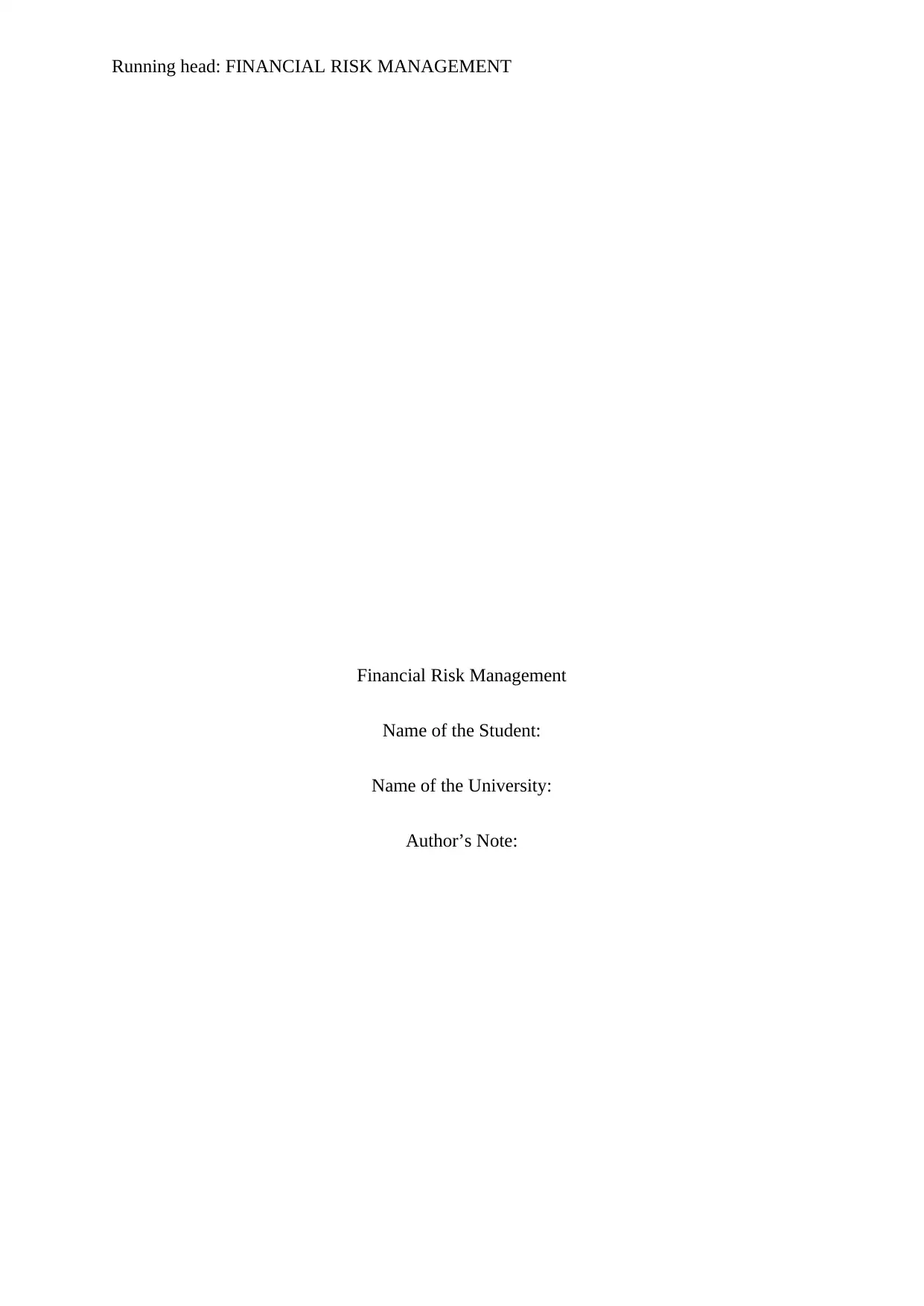
Running head: FINANCIAL RISK MANAGEMENT
Financial Risk Management
Name of the Student:
Name of the University:
Author’s Note:
Financial Risk Management
Name of the Student:
Name of the University:
Author’s Note:
Paraphrase This Document
Need a fresh take? Get an instant paraphrase of this document with our AI Paraphraser
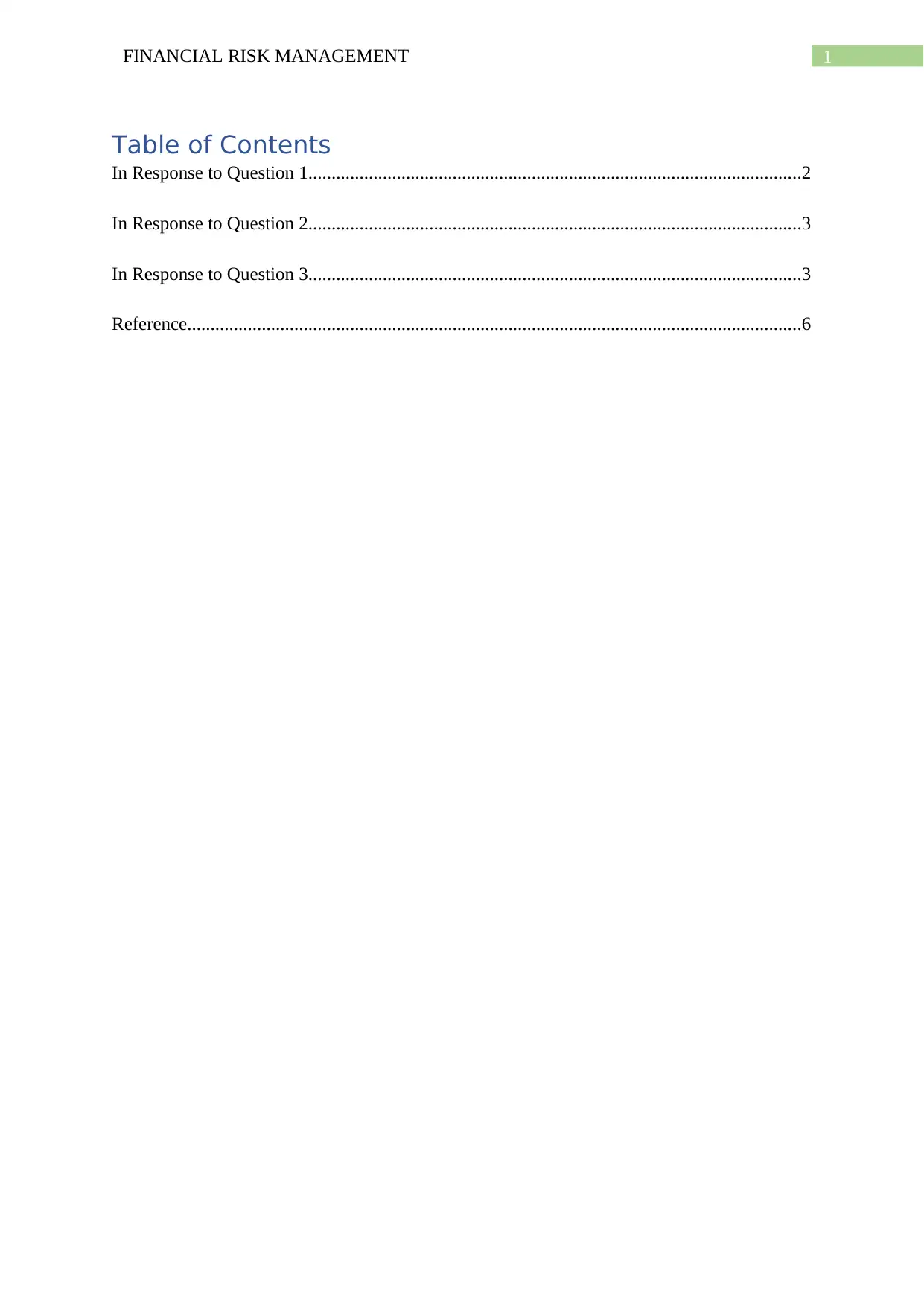
1FINANCIAL RISK MANAGEMENT
Table of Contents
In Response to Question 1..........................................................................................................2
In Response to Question 2..........................................................................................................3
In Response to Question 3..........................................................................................................3
Reference....................................................................................................................................6
Table of Contents
In Response to Question 1..........................................................................................................2
In Response to Question 2..........................................................................................................3
In Response to Question 3..........................................................................................................3
Reference....................................................................................................................................6
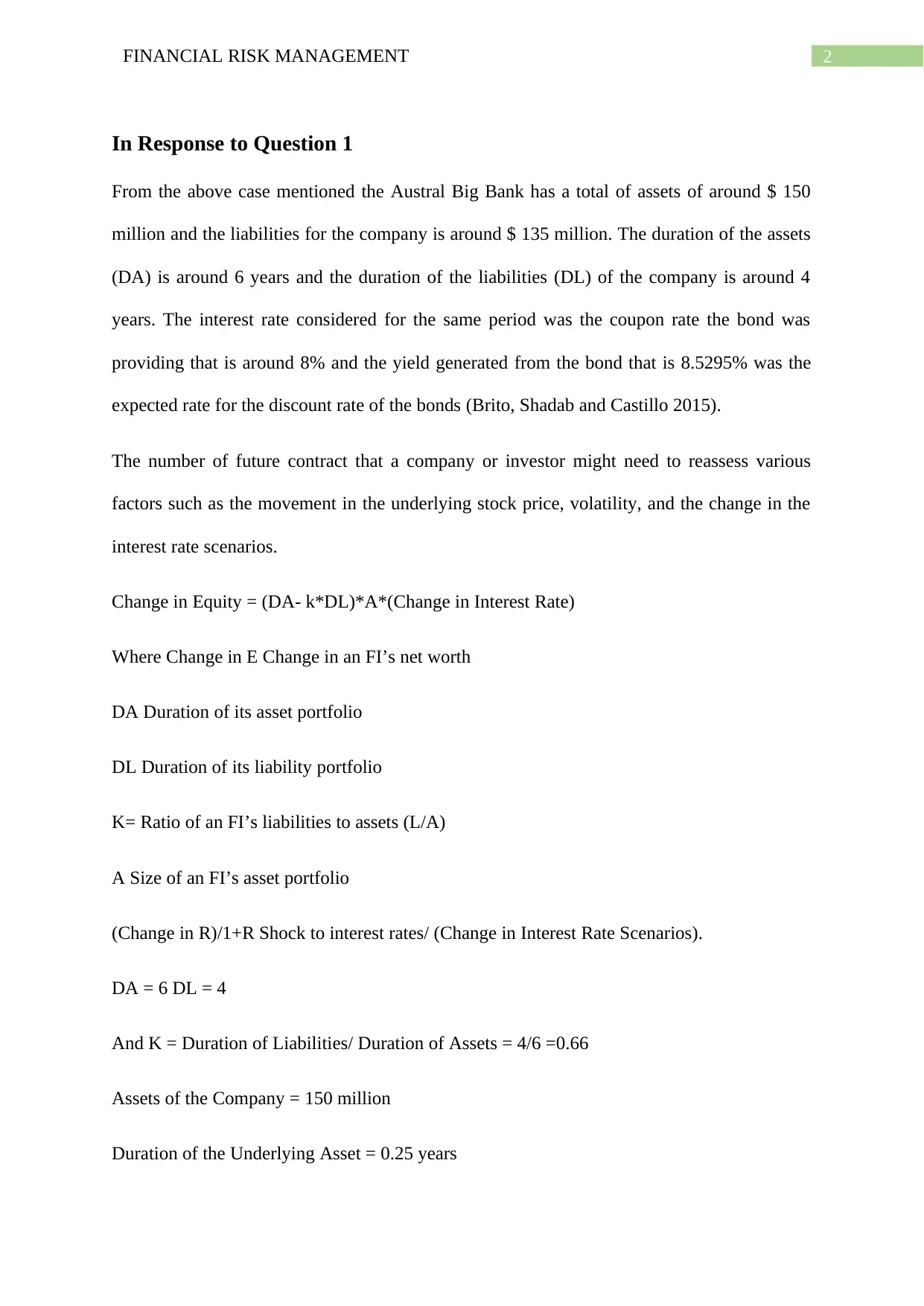
2FINANCIAL RISK MANAGEMENT
In Response to Question 1
From the above case mentioned the Austral Big Bank has a total of assets of around $ 150
million and the liabilities for the company is around $ 135 million. The duration of the assets
(DA) is around 6 years and the duration of the liabilities (DL) of the company is around 4
years. The interest rate considered for the same period was the coupon rate the bond was
providing that is around 8% and the yield generated from the bond that is 8.5295% was the
expected rate for the discount rate of the bonds (Brito, Shadab and Castillo 2015).
The number of future contract that a company or investor might need to reassess various
factors such as the movement in the underlying stock price, volatility, and the change in the
interest rate scenarios.
Change in Equity = (DA- k*DL)*A*(Change in Interest Rate)
Where Change in E Change in an FI’s net worth
DA Duration of its asset portfolio
DL Duration of its liability portfolio
K= Ratio of an FI’s liabilities to assets (L/A)
A Size of an FI’s asset portfolio
(Change in R)/1+R Shock to interest rates/ (Change in Interest Rate Scenarios).
DA = 6 DL = 4
And K = Duration of Liabilities/ Duration of Assets = 4/6 =0.66
Assets of the Company = 150 million
Duration of the Underlying Asset = 0.25 years
In Response to Question 1
From the above case mentioned the Austral Big Bank has a total of assets of around $ 150
million and the liabilities for the company is around $ 135 million. The duration of the assets
(DA) is around 6 years and the duration of the liabilities (DL) of the company is around 4
years. The interest rate considered for the same period was the coupon rate the bond was
providing that is around 8% and the yield generated from the bond that is 8.5295% was the
expected rate for the discount rate of the bonds (Brito, Shadab and Castillo 2015).
The number of future contract that a company or investor might need to reassess various
factors such as the movement in the underlying stock price, volatility, and the change in the
interest rate scenarios.
Change in Equity = (DA- k*DL)*A*(Change in Interest Rate)
Where Change in E Change in an FI’s net worth
DA Duration of its asset portfolio
DL Duration of its liability portfolio
K= Ratio of an FI’s liabilities to assets (L/A)
A Size of an FI’s asset portfolio
(Change in R)/1+R Shock to interest rates/ (Change in Interest Rate Scenarios).
DA = 6 DL = 4
And K = Duration of Liabilities/ Duration of Assets = 4/6 =0.66
Assets of the Company = 150 million
Duration of the Underlying Asset = 0.25 years
⊘ This is a preview!⊘
Do you want full access?
Subscribe today to unlock all pages.

Trusted by 1+ million students worldwide
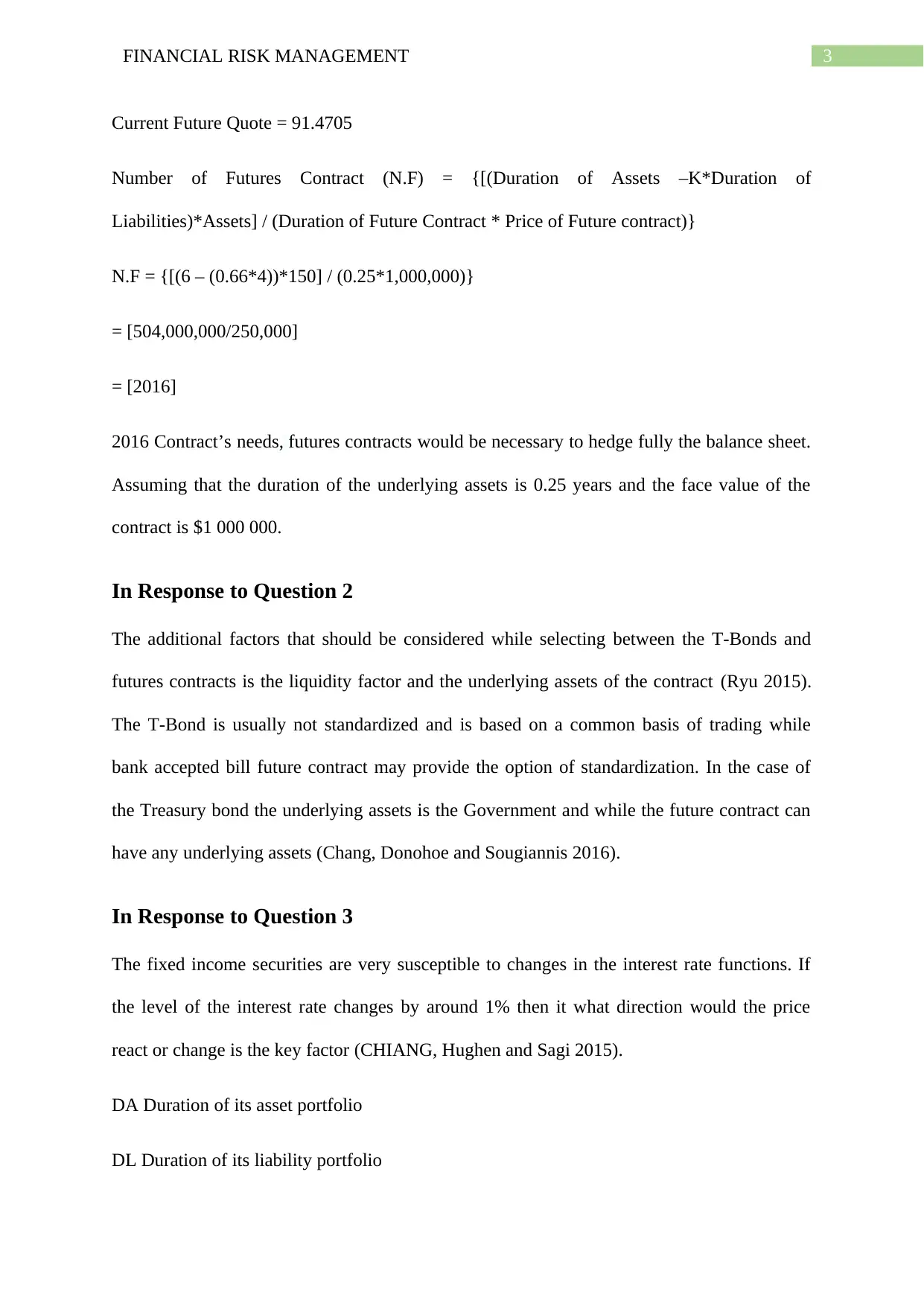
3FINANCIAL RISK MANAGEMENT
Current Future Quote = 91.4705
Number of Futures Contract (N.F) = {[(Duration of Assets –K*Duration of
Liabilities)*Assets] / (Duration of Future Contract * Price of Future contract)}
N.F = {[(6 – (0.66*4))*150] / (0.25*1,000,000)}
= [504,000,000/250,000]
= [2016]
2016 Contract’s needs, futures contracts would be necessary to hedge fully the balance sheet.
Assuming that the duration of the underlying assets is 0.25 years and the face value of the
contract is $1 000 000.
In Response to Question 2
The additional factors that should be considered while selecting between the T-Bonds and
futures contracts is the liquidity factor and the underlying assets of the contract (Ryu 2015).
The T-Bond is usually not standardized and is based on a common basis of trading while
bank accepted bill future contract may provide the option of standardization. In the case of
the Treasury bond the underlying assets is the Government and while the future contract can
have any underlying assets (Chang, Donohoe and Sougiannis 2016).
In Response to Question 3
The fixed income securities are very susceptible to changes in the interest rate functions. If
the level of the interest rate changes by around 1% then it what direction would the price
react or change is the key factor (CHIANG, Hughen and Sagi 2015).
DA Duration of its asset portfolio
DL Duration of its liability portfolio
Current Future Quote = 91.4705
Number of Futures Contract (N.F) = {[(Duration of Assets –K*Duration of
Liabilities)*Assets] / (Duration of Future Contract * Price of Future contract)}
N.F = {[(6 – (0.66*4))*150] / (0.25*1,000,000)}
= [504,000,000/250,000]
= [2016]
2016 Contract’s needs, futures contracts would be necessary to hedge fully the balance sheet.
Assuming that the duration of the underlying assets is 0.25 years and the face value of the
contract is $1 000 000.
In Response to Question 2
The additional factors that should be considered while selecting between the T-Bonds and
futures contracts is the liquidity factor and the underlying assets of the contract (Ryu 2015).
The T-Bond is usually not standardized and is based on a common basis of trading while
bank accepted bill future contract may provide the option of standardization. In the case of
the Treasury bond the underlying assets is the Government and while the future contract can
have any underlying assets (Chang, Donohoe and Sougiannis 2016).
In Response to Question 3
The fixed income securities are very susceptible to changes in the interest rate functions. If
the level of the interest rate changes by around 1% then it what direction would the price
react or change is the key factor (CHIANG, Hughen and Sagi 2015).
DA Duration of its asset portfolio
DL Duration of its liability portfolio
Paraphrase This Document
Need a fresh take? Get an instant paraphrase of this document with our AI Paraphraser
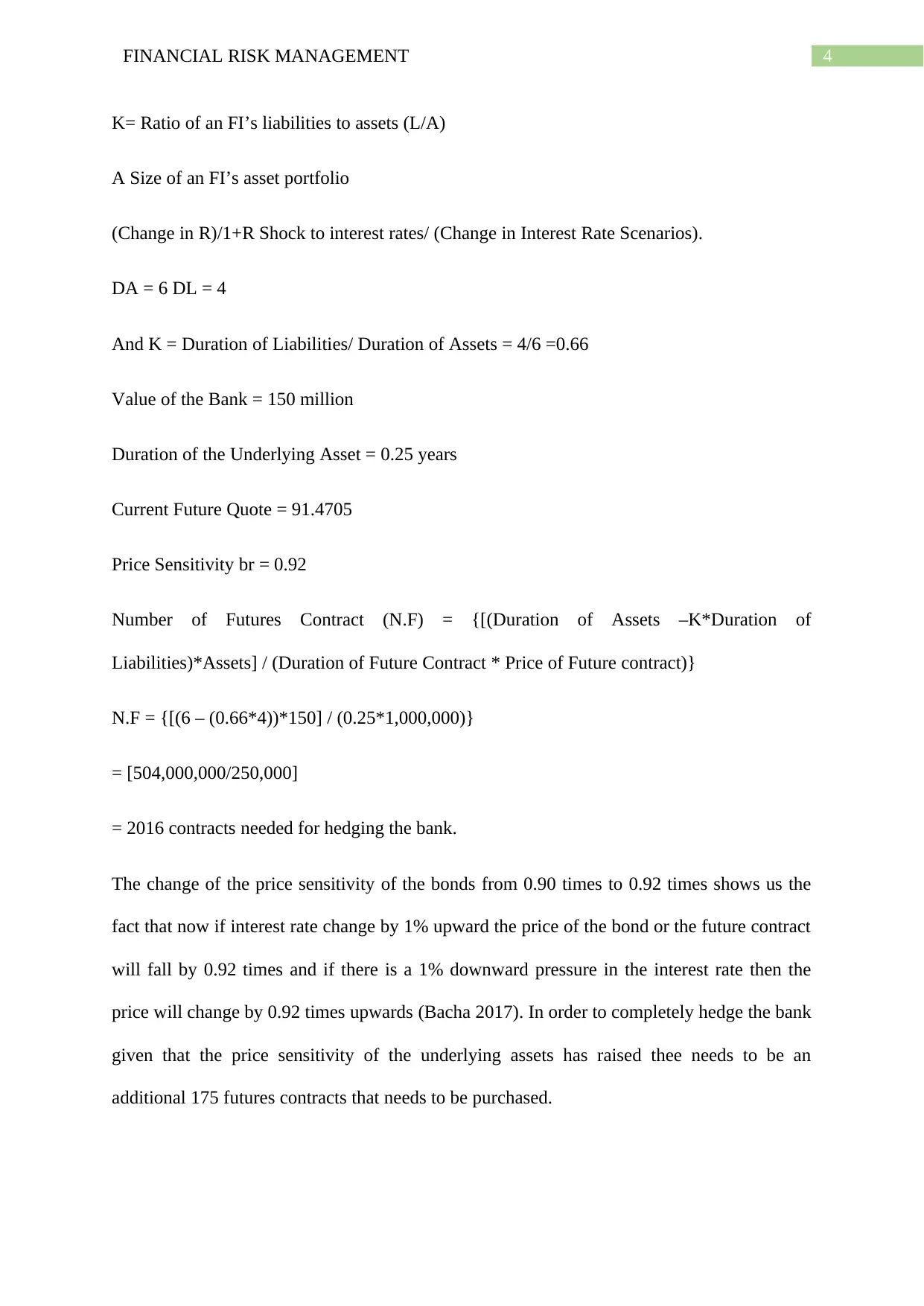
4FINANCIAL RISK MANAGEMENT
K= Ratio of an FI’s liabilities to assets (L/A)
A Size of an FI’s asset portfolio
(Change in R)/1+R Shock to interest rates/ (Change in Interest Rate Scenarios).
DA = 6 DL = 4
And K = Duration of Liabilities/ Duration of Assets = 4/6 =0.66
Value of the Bank = 150 million
Duration of the Underlying Asset = 0.25 years
Current Future Quote = 91.4705
Price Sensitivity br = 0.92
Number of Futures Contract (N.F) = {[(Duration of Assets –K*Duration of
Liabilities)*Assets] / (Duration of Future Contract * Price of Future contract)}
N.F = {[(6 – (0.66*4))*150] / (0.25*1,000,000)}
= [504,000,000/250,000]
= 2016 contracts needed for hedging the bank.
The change of the price sensitivity of the bonds from 0.90 times to 0.92 times shows us the
fact that now if interest rate change by 1% upward the price of the bond or the future contract
will fall by 0.92 times and if there is a 1% downward pressure in the interest rate then the
price will change by 0.92 times upwards (Bacha 2017). In order to completely hedge the bank
given that the price sensitivity of the underlying assets has raised thee needs to be an
additional 175 futures contracts that needs to be purchased.
K= Ratio of an FI’s liabilities to assets (L/A)
A Size of an FI’s asset portfolio
(Change in R)/1+R Shock to interest rates/ (Change in Interest Rate Scenarios).
DA = 6 DL = 4
And K = Duration of Liabilities/ Duration of Assets = 4/6 =0.66
Value of the Bank = 150 million
Duration of the Underlying Asset = 0.25 years
Current Future Quote = 91.4705
Price Sensitivity br = 0.92
Number of Futures Contract (N.F) = {[(Duration of Assets –K*Duration of
Liabilities)*Assets] / (Duration of Future Contract * Price of Future contract)}
N.F = {[(6 – (0.66*4))*150] / (0.25*1,000,000)}
= [504,000,000/250,000]
= 2016 contracts needed for hedging the bank.
The change of the price sensitivity of the bonds from 0.90 times to 0.92 times shows us the
fact that now if interest rate change by 1% upward the price of the bond or the future contract
will fall by 0.92 times and if there is a 1% downward pressure in the interest rate then the
price will change by 0.92 times upwards (Bacha 2017). In order to completely hedge the bank
given that the price sensitivity of the underlying assets has raised thee needs to be an
additional 175 futures contracts that needs to be purchased.
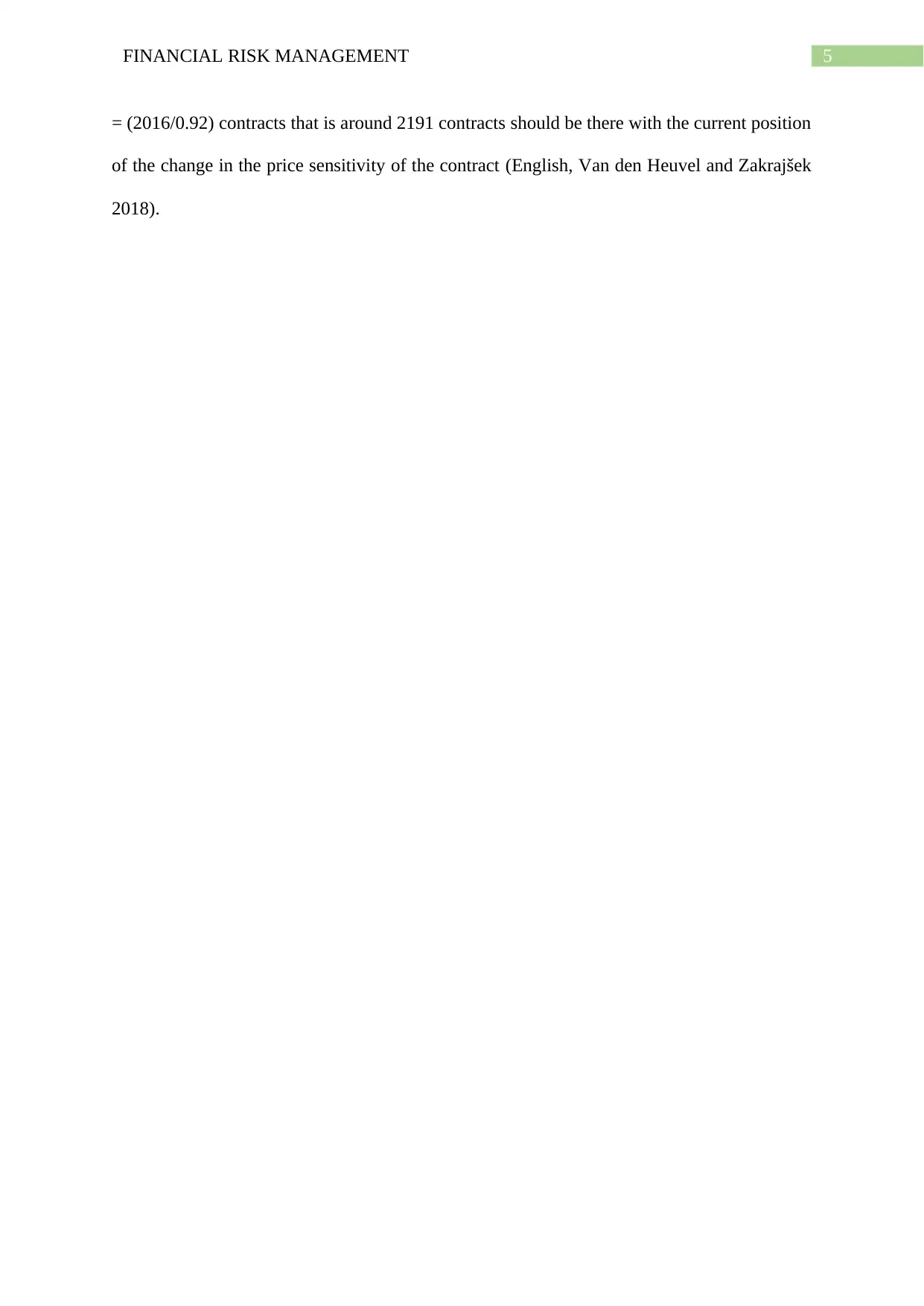
5FINANCIAL RISK MANAGEMENT
= (2016/0.92) contracts that is around 2191 contracts should be there with the current position
of the change in the price sensitivity of the contract (English, Van den Heuvel and Zakrajšek
2018).
= (2016/0.92) contracts that is around 2191 contracts should be there with the current position
of the change in the price sensitivity of the contract (English, Van den Heuvel and Zakrajšek
2018).
⊘ This is a preview!⊘
Do you want full access?
Subscribe today to unlock all pages.

Trusted by 1+ million students worldwide
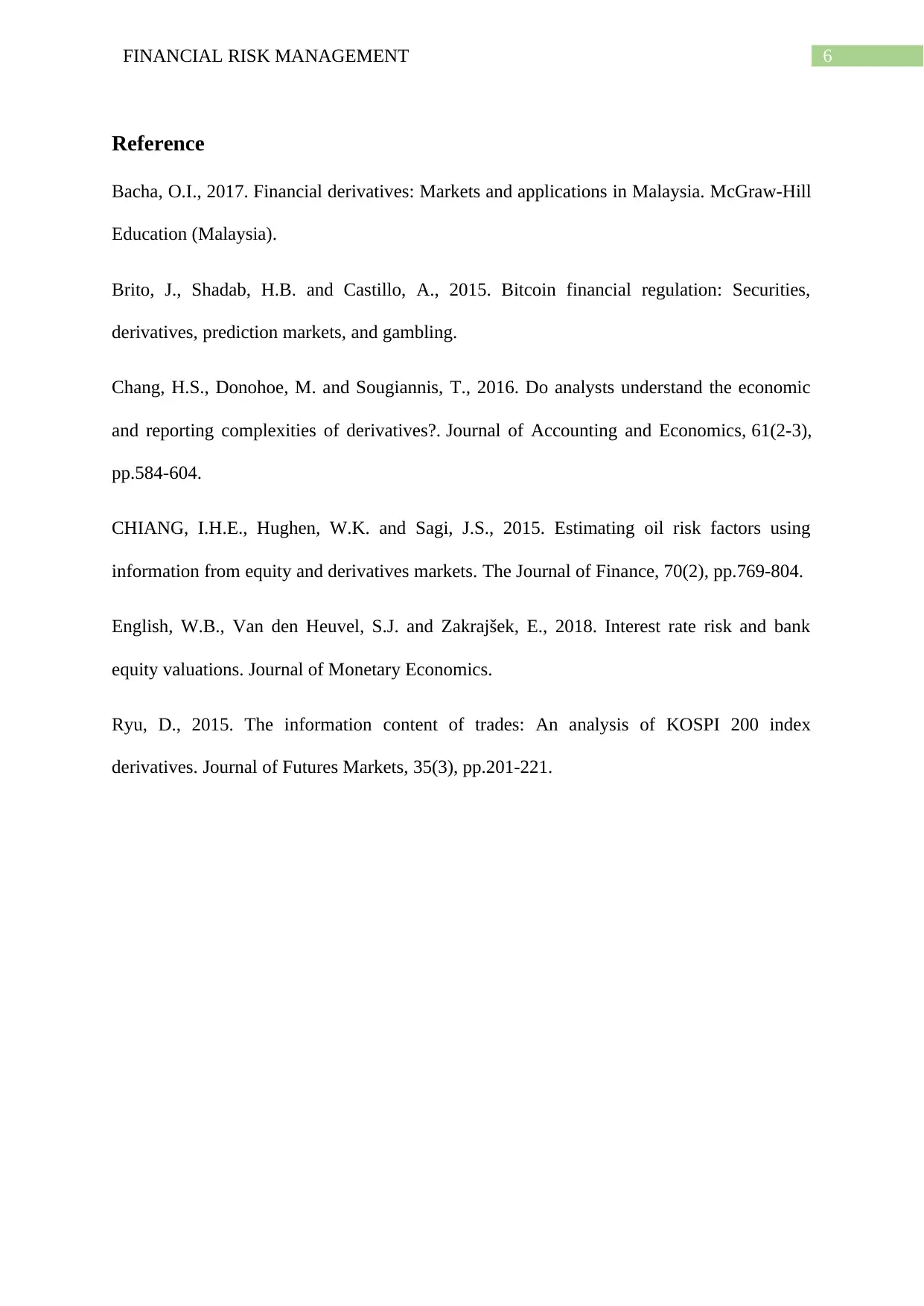
6FINANCIAL RISK MANAGEMENT
Reference
Bacha, O.I., 2017. Financial derivatives: Markets and applications in Malaysia. McGraw-Hill
Education (Malaysia).
Brito, J., Shadab, H.B. and Castillo, A., 2015. Bitcoin financial regulation: Securities,
derivatives, prediction markets, and gambling.
Chang, H.S., Donohoe, M. and Sougiannis, T., 2016. Do analysts understand the economic
and reporting complexities of derivatives?. Journal of Accounting and Economics, 61(2-3),
pp.584-604.
CHIANG, I.H.E., Hughen, W.K. and Sagi, J.S., 2015. Estimating oil risk factors using
information from equity and derivatives markets. The Journal of Finance, 70(2), pp.769-804.
English, W.B., Van den Heuvel, S.J. and Zakrajšek, E., 2018. Interest rate risk and bank
equity valuations. Journal of Monetary Economics.
Ryu, D., 2015. The information content of trades: An analysis of KOSPI 200 index
derivatives. Journal of Futures Markets, 35(3), pp.201-221.
Reference
Bacha, O.I., 2017. Financial derivatives: Markets and applications in Malaysia. McGraw-Hill
Education (Malaysia).
Brito, J., Shadab, H.B. and Castillo, A., 2015. Bitcoin financial regulation: Securities,
derivatives, prediction markets, and gambling.
Chang, H.S., Donohoe, M. and Sougiannis, T., 2016. Do analysts understand the economic
and reporting complexities of derivatives?. Journal of Accounting and Economics, 61(2-3),
pp.584-604.
CHIANG, I.H.E., Hughen, W.K. and Sagi, J.S., 2015. Estimating oil risk factors using
information from equity and derivatives markets. The Journal of Finance, 70(2), pp.769-804.
English, W.B., Van den Heuvel, S.J. and Zakrajšek, E., 2018. Interest rate risk and bank
equity valuations. Journal of Monetary Economics.
Ryu, D., 2015. The information content of trades: An analysis of KOSPI 200 index
derivatives. Journal of Futures Markets, 35(3), pp.201-221.
1 out of 7
Related Documents
Your All-in-One AI-Powered Toolkit for Academic Success.
+13062052269
info@desklib.com
Available 24*7 on WhatsApp / Email
![[object Object]](/_next/static/media/star-bottom.7253800d.svg)
Unlock your academic potential
Copyright © 2020–2025 A2Z Services. All Rights Reserved. Developed and managed by ZUCOL.


